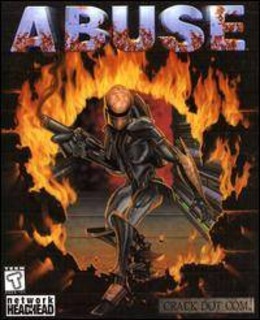Abuse's first impression was it's rather creepy, in a good way. In-game environments are dank, foreboding and even the most spacious of places, quite atmospherically claustrophobic. Couple that with a silent protagonist in strange looking armor (even for the 1990s) and his equally creepy and dangerous adversaries, it's easy to nominate Abuse for many awards in the year that it was released.
The controls scheme is the second thing that players would notice. Abuse is likely one of the first games to fully use the keyboard and mouse to direct its player character in orientations that include the vertical axis (games of that time either used some aim-botting to help targets enemies above the player character or simply has only one single layer in the vertical direction), albeit it is still restricted in a 2-D plane as a side-scrolling game should be.
The sounds are next, and like the visuals, they are eerie and ominous. Off-screen enemies murmur and croon, like holding back their excitement and eagerness while waiting for the player character to approach. Weapons do not look particularly flashy or impressive in this game, but their sounds pack a wallop.
There is much glee to be gained when obtaining a location of strategic value and gunning down the many enemies in this game.
Sadly, that is all the fun that a player could get from the game. Plot-wise, it would appear that the developer, Crack dot Com, cannot come to grasp with finalizing the gist of the story, resulting in a bizarre plot filled with contradictions and loopholes. There is hardly anything plot-related to drive the player forward.
(And they never improved on their story writing either. Crack dot Com's would-be second game, Golgotha, had an even more bizarre story bordering on the bogus. That game was never released, and probably for the better too as it appeared to jumble up all conceivable political, religious and supernatural theories together.)
Next, we have the lousy level designs, which appear to clash with the theme and setting of the game, making little architectural sense (spacious caverns with on-rails platforms seem more fitting in ore mines, not the clandestine sci-fi-prison-cum-research-facility that the game is set in). Throw in the fact that enemies respawn off-screen, and this game is frustratingly difficult to navigate through.
It is rather unfortunate then, that Abuse's contribution to the gaming industry ended up being utilized in nothing more than games that can be run using Java or Flash - hardly any games with full-fledged unique coding. Perhaps it suffers the stigma of being just a side-scroller with an interesting control scheme - which is how I see it.
Considering that one of the games' publishers (the evil Electronic Arts) has devoured the other (Origin Systems), and that its developer, Crack dot Com, released the source code for this game (and the aforementioned Golgotha) to the public, this IP will never see the light of the day ever again.
This reviewer does admit feeling guilty ending this review on quite a sour note, but it should be noted that Abuse had much potential, which was never realized.

